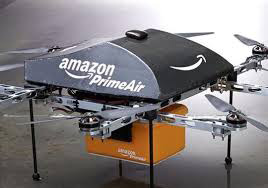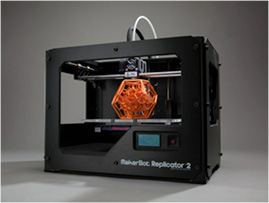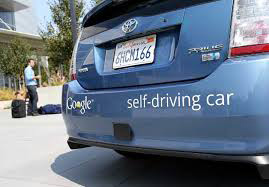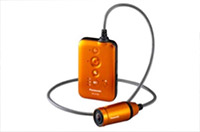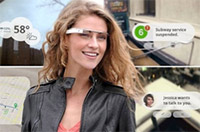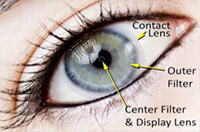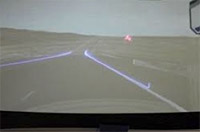|
There is an ancient childhood game, Spoons, in which there is one less spoon in the center of the table, than there are players at the table. The goal of the game is for players, through trading with the others, "to be the first to collect four cards of the same rank. [For example, passing a single face-down card to the player on the left and receiving the same from a player on the right, until, perchance, four "3s" are in the player's hand.] If an opponent beats you to that goal, to not be the last to realize it." The first player to get the four cards, "sneakily" removes a spoon from the center of the table. The next player to notice this removal, also removes one, and the last to notice - no spoons remaining - is the loser of that round. The purpose of this Views is to alert you to some features of the global retail game that bear an amazing similarity to Spoons. In the interests of YOU not being the one reaching for a spoon when they are all gone, here's to GREAT "Shopping" for YOU! 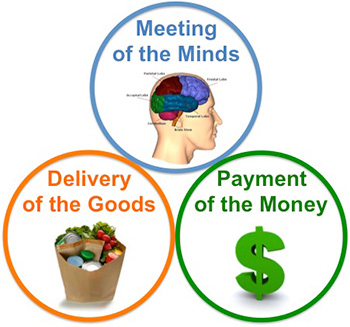
Readers of the Views should be familiar with this tri-partite thinking about retailing. In the present issue we will deal in some detail with the progress of the "Delivery of the Goods" share of the business. The issue, Selling Like Amazon... in Bricks & Mortar Stores!, deals in some detail with the "Meeting of the Minds" portion of the business, and touches briefly on the pending role of the smart phone in the "Payment of the Money" aspect (another Views, yet pending.) As detailed as these issues of the Views are, they are not nearly as detailed as any cutting edge retailer should be thinking today. They are intended simply to "nudge" the industry closer to true scientific retailing. Never forget that the entire retail industry is built on the massive efficiency of society, driven in its most basic element, by free agents producing what they are best and most efficient at producing, and the consequent need of getting that production into the hands of the wider universe of free agents whose needs and desires are satisfied by that production - the consumers/users. This separation of production from consumption is at the foundation of societal efficiency, and unavoidably creates the need for commerce to both deliver the production across the void we will discuss here, but also create a balanced system, where there is a countervailing flow of money, in the reverse direction - supported by the offsetting production of the consumers. Consumers are producers, too! - thus, gluing societies together. Earlier issues of the Views have dealt with these broad societal roles of efficiency inside retail, Efficiency & Convenience: An Introduction to "The Third Wave" of Retailing, and the consequent role of retail as a driving force in social evolution: Retailing: the Trojan Horse of Global Freedom and Prosperity. Here we will focus on the physical movement of production from its origin to the customer/consumer, "Delivery of the Goods." 1. The Delivery Spectrum The diagram below outlines the options for moving production to customers/consumers. Most of this broad spectrum has been conceptually and practically in existence for millennia, but the world has irreversibly changed in the past few years in ways that make what was, not so practical in the world that is, and what soon will be. Whether soon or late, the migration will be to greater efficiency: 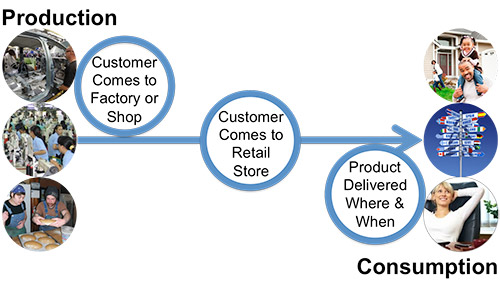
The separation created by the division of labor is incredibly complex, varying from shops or factories quite near population centers where the consumption of production will occur. This creates a situation where the customer/consumer may directly access the production at the source, the factory, shop or craftsman. Let's begin by considering options on both ends of the delivery spectrum, it is worthwhile noting an extreme for factory delivery, where an American purchases a car from the factory in Germany, and travels to Germany to pick it up. Obviously no one would do this for a loaf of bread. The opposite end of the scale is the door-to-door salesman (or home party salesperson,) who brings merchandise to the customer/consumer at home or office. [We can actually extend this all the way into the pantry or storage - even the table.] As usual, examining extremes gives us a better perspective of the ordinary, not in understanding averages, but in understanding the underlying forces that drive both the ordinary (averages) and the extraordinary (the extremes.) So we have three basic modalities of "delivery:"
The major purpose of this Views is to show how and why this "halfway" solution came to dominate retail, and how fundamental facts on the ground have so radically changed, that much of the original reasons for the store are seriously compromised. 2. The Store as an Intermediate "Warehouse" Without going through the catalog of how and why mass retailing came about 100 years ago, (see Efficiency & Convenience: An Introduction to "The Third Wave" of Retailing,) it is helpful to note that the beginning of the second wave of retailing involved introducing the massive efficiencies of the modern warehouse style supermarket. Bear in mind that in the United States, in the 1920s, there were something like 500,000 stores, doing a small fraction of the volume of business done today by less than 100,000 stores. And the share of that business that is groceries has plummeted, as a share of household expenditures, although groceries continue to lead the way in driving trip frequency. Two essential features of these new stores were and are:
Retailers actually do focus a good deal of attention on what are in fact delivery issues for themselves: the location and size of the stores. And these two issues are "joined" at the hip, in practice. It's hard to imagine a retailer siting a store who is not thinking of the real estate mantra, "location, location, location." But they are probably more thinking of capturing store traffic than they are in thinking about delivery to the customers. OK, practically, it is the same thing, but in mind-set, one is about you taking things to the customer, and the other is about the customer coming to you - "come and get it!" As we have already noted, of course the store is a compromise with the retailer coming "half-way." But very successful retailers all over the world are moving in the direction of smaller stores, and more of them - the small store movement. Putting the small store movement into the context of delivery, one can see that building a lot more of the smaller stores is one way to get closer to the customers, essentially requiring the shopper to spend less of their own time and money getting to the retailer. The retailer is thereby delivering further to the customer, by having the store closer to the customer. This shifts the store in the direction of being a communal pantry, with the role of the "store pantry" increasingly blurred with the home or office "pantry." Once you see this all put into the delivery context, it's easy to see that home delivery a la Amazon and other online retailers, is simply the retailer going the whole way in terms of the delivery, and NOT expecting the customer to bear any of this delivery cost. The big point we are making here is that the bricks-and-mortar store model already has a LARGE, indeterminate delivery cost to the shopper, in terms of the "The Three Shopping Currencies," money-time-angst. In some ways, online retail challenges the bricks retailer by driving efficiencies in these non-accounted for areas of traditional shopper costs, at bricks retail stores. (We will discuss later the VERY large capital and inventory costs associated with these bricks stores.) Amazon Prime, where the shopper pays an annual fee for free, 2-day delivery on most merchandise is effectively equivalent to the Costco annual membership fee in pricing. But it is not really a "new" charge to shoppers. In reality, if the very real, but ignored cost of self-delivery from the bricks stores is considered, Amazon's annual Prime fee is probably a bargain. Costco, as a bricks retailer, is more similar to Amazon in their store operations than many have recognized. This is both because of their navigation structure and at least quasi-algorithmic selling process. See: Selling Like Amazon... in Bricks & Mortar Stores! Those two "inside the store" factors are sufficient to overcome any "self-delivery" deficits Costco may have. Also, Costco is violating world trends in retail - the small store movement, for example - by not only building large stores, but putting them in semi-inconvenient areas. Large stores/semi-inconvenient areas are a natural, in terms of lower capital costs, and encouraging shoppers who come there to do maximum shopping. This sounds counterintuitive to our drive for efficiency, but we know that shoppers who drive to a store will shop it more thoroughly than if they happen upon the store in a mall, for example. Also, Jim Sinegal of Costco publicly stated that they do not provide in-store maps of the merchandise locations because they do not necessarily want shoppers to find what they want right away. For a related reason, they have no express checkout lanes: why encourage small baskets? These blatant non-accommodations for shoppers are offset by cleverly selling faster. That is, the number of seconds it takes for Costco to close on a dollar's worth of merchandise is five times faster than for some of their competitors. We could ignore Amazon and Costco, if they were not both growing at outsize rates, moving rapidly up the ranks of global retailers - Costco now #3. The Costco rank is simply astounding, pushing Tesco down the listings, with Carrefour almost certain to cede the #2 slot soon. The commentariat and press obsess about Amazon's continuing climb, while nearly ignoring Costco. (How much general coverage did you see of the Google/Costco partnership in a same day delivery of online orders from Costco, in one city, this past holiday season? See: Costco and Google Testing Same Day Delivery in San Francisco ...) This would be more shocking if one did not understand the fundamentals of retailing as we are discussing them in the Views, and with the emerging realization that Costco is taking an approach to retail efficiency that is related to the Amazon approach, but in a "hidden in plain sight" manner, very evocative of a "Retail Spoons," company.
That is, there are real opportunities in pursuing "outside the historical box" approaches - think of these techniques as "retail spoons" that some retailers are grabbing from the table; while others are apparently oblivious to what is going on around them. Amazon, on the other hand, is taking more of a "this is the future of retail," and we are testing/doing it right now! Whereas in Selling Like Amazon... in Bricks & Mortar Stores!, we dealt with potential Amazonian efficiency on the bricks retail floor, here we are putting potential immediate delivery by drone from an online store, on the horizon. Amazon's bold Amazon Prime Air, with a goal of 30 minute deliveries to homes in major metro areas, is a vision that threatens the door-to-door salesman, for immediacy and convenience of delivery... not to mention upping the ante for bricks retailers.
Then there is this: Amazon's plans for autonomous flying delivery drones are so last year. The ecommerce juggernaut is purportedly working on something far more dystopian: pre-shipment. Amazon has filed a patent for a shipping system designed to cut delivery times by predicting what buyers are going to buy before they buy it - and shipping products in their general direction, or even right to their door, before the sales click even (or ever) falls. [From Tech Crunch; see also, Amazon Wants to Ship Your Package Before You Buy It, Wall Street Journal.] "Things will not return to how they were before." (Pope Francis) We have experienced massive change over the past 20 years - essentially, the "personal" computer and internet; culminating in the smart phone (personal computers in our pockets or purses,) which have a two way connection to the world - all the public information in the world (via Google and its ilk,) and making public all our own personal information to the world. That "all" and "personal" are the cutting edge of big, BIG, BIG data, the battle over which has just been joined with minor skirmishes, compared with what is to come. Shipping packages before you purchase is just pressing the edge with big data. There are tremendous significances to all this, for retail. First, obviously this has made online retail possible, and continues to drive the growth of Amazon and all the other players in the field, including bricks retailers struggling to perform credibly in the online space themselves. But note that after 20 years of online growth, it's at something like 8% of total retail at this point. Since we are discussing the delivery of merchandise, it is appropriate to do a quick review of a few developments that are, or will, impact delivery at retail, both online and offline. All this is teeing up the ball for further changes in how retail is practiced. Here we are emphasizing how the very basic component of delivery is evolving in significant ways. None of this is said to suggest a limited life for bricks stores, but rather that their role will be played by some new players, while some of the old players recede or vanish. Remember, Sears provided an alternate delivery modality last century when self-service retailing was radically altering the retail world - by pioneering an alternate form of delivery, non-store, by mail order. After Sears had become, themselves, a major bricks retailer, it was not Sears that leveraged the explosive growth of "mail order" delivery this century, but Amazon! Expect continuing changes in delivery methods to roil further the industry, moving forward. Bricks-and-mortar delivery as a modality is unlikely to disappear, but the struggle to get the merchandise closer to the customer will certainly involve turmoil in the shelf-shopper interface. The half measure of supply chain delivery to the store will be seriously challenged.
So we draw a line here, with maybe two of the retail spoons already taken from the table, and a proper question as to how long it is going to take for some centi-billion dollar companies to take any kind of adequate responses to the game that has been long since afoot? First, let me point out that my primary concern is, and will remain, the welfare of the shoppers in the "store," taken broadly. A dozen years ago we learned through tracking hundreds of thousands of shoppers through stores, observing their individual behaviors on a second by second basis, that upwards of 80% of their time in the store was wasted. That is, it served no useful, productive purpose for either themselves or the retailers. (See also: The 'Traveling Salesman' Goes Shopping: The Efficiency of Purchasing Patterns in the Grocery Store.) These observations led to the immediate recognition that all that wasted time represented a massive selling opportunity. The ensuing years have willy nilly focused on how to use that time to create sales, and this is a common theme of my writings over those years. But this interest in how to sell has very deep roots, indeed, for me. At the age of eleven I owned my own fresh donut distribution business, selling and delivering donuts to customers, supplied by a local shop. For retailing today, I do not intend to shift my interest from sales to delivery, but I can't help but reflect on gross inefficiencies I see in delivery, some of which are intertwined with the selling process. Recognition of inefficiencies in delivery is, to my way of thinking, justifying drawing the line, and grabbing the second spoon, above. 3. Coming "Someday," Just-in-Time (JIT) IN Bricks Stores The inefficiency I have belatedly recognized is semi-dead inventory, noted above: "Whole lot of nuttin' goin' on, here!" There is of course nothing new in my recognition of the need for management of the long tail in bricks stores. And I have noted the powerful attractive force that all that static merchandise has, in terms of getting shoppers into the store - bricks or online. Of course, online may have near zero cost for that non-selling inventory - possibly consisting of nothing more than a digital record. However, it is VERY costly for the bricks retailer. (See: The Misguided Bobbing of the Long Tail.) Those costs are ultimately passed on to shoppers. The shopper ultimately pays for everything, and bricks stores ignoring the costs that they are sloughing off on shoppers, that online retailers are not, will come back to bite bricks retailers. On a recent visit to New York City I couldn't help but think of what must be the many billions of dollars of merchandise deployed in the emporia of this city. It makes the inefficiency of delivery to shoppers from just this one small geographic locus seem massive. Even with quite a few million shoppers on a daily basis, there must still remain a massive amount of quiescent merchandise, resting quietly in warehouse and retailer assigned spaces, waiting patiently for rare purchases of the specific items, hopefully before finally making their way to clearance bins. The cost of all this futile in-store warehousing must ultimately be borne by shoppers. I'm well aware of the long tail benefit, as referenced above. But online retail is not the only way to leverage profitably the long tail. However, through the Convergence of Online, Mobile and Bricks (COMB) retailing, delivery inefficiency can be achieved. And, by the way, there are bricks retailers who are already using online retail to guide their bobbing of the long tail in the bricks store. 4. Comes the Robot(s) With this perspective, we will consider some further developments that are certain to have massive impacts, particularly on the delivery spectrum (from manufacturers to consumers.) These can all be subsumed under the category of robots, because in every case, some aspect of digital information processing drives some aspect of the physical delivery process. The Amazon Prime Air drone is an obvious example. Our second example is 3D printing, illustrated by the MakerBot:
3D printing prints successive layers of material to build up the 3D object, driven by digital (CAD) maps for each successive layer. The machine pictured here costs a couple thousand dollars, but some hobbyist versions are only a few hundred dollars, with high-end machines being very much more. ;-) But thinking about these capabilities requires recognition that entire classic cars are now producible by this technology! This kind of technology is very appropriate for thinking about the long tail. How many people really want a classic car? Not many. But someday, every classic car extant today will likely have the 3D blueprints required to produce one. For retailing, think of it as just a little more complicated than printing books and articles on demand. In other words, manufacturing could be done right in the store, right now, for simple items. This would not be for food, for sure - at least not yet! - but certainly slow moving plastic inventory could be reduced to a minimum, with, in some cases, only a couple copies actually on the shelf. When one is purchased, the printer in the back room will add that to the print queue for replacement in the next few hours, always keeping minimal long tail inventory on hand. An inventory of the "ink" material is all that is needed, along with the printer. Customization will be easy! Creatives can produce not yet imagined products, even in their own homes!!! The point here is that 3D printing is not some pie-in-the-sky technology, (see: 3-D printing takes shape, McKinsey Quarterly) maybe happening in the distant future. It has already arrived, and will be especially useful - not necessarily for mass production, right now - but for customization and long tail inventory! And the reason for considering a manufacturing device under delivery is that the entire manufacturing process can move across the delivery spectrum. The old silos may become obsolete before you are ready for them to. Think about the impact JIT, Just-in-Time, began having years ago on the efficiency of manufacturing plants. Now apply those principles progressively across the entire delivery spectrum of retail and the explosion in productivity could swell well beyond the potential of improving shopper efficiency on the sales floor! You should be grabbing spoons! The self-driven car may already know when it is time to make another trip to the store, and from the shopping list and the stores' inventories/prices even know where to take you! Maybe it can go to the store and take delivery of your scheduled, or online orders, on it's own?
Perhaps instead of you stopping on the way home - or to the office - you simply send the car to pickup an item you just spotted on your smart phone while on your break at work. The possibilities of your own personal "car and driver" are large, and having it do deliveries for you as well as to you will be a godsend at times. These next four technologies all revolve around vision. Vision doesn't deliver things, per se, but it is the crucial function that guides delivery of merchandise all the way from production in the manufacturing plant to the shoppers' acceptance, whether online, mobile or bricks, and their ultimate consumption or use of the production. Hence, the eye of the robot and of the human serve similar specialized functions. Hopefully the significance of this "human eye/robot eye" discussion will become apparent before we finish this discussion.
The micro camera and Google Glass are both compiling digitized visual information suitable for feeding into big, BIG, BIG data. The Google Glass and the contact lens display, are both for augmenting the reality of the of the human user, with the Google Glass also serving as the agent to pass to the cloud what the human observer is seeing, and return, via the screen, some augmentation of the reality being natively seen. The augmented reality windshield overcomes sensory limitations of the human, and uses infrared and other sensors to see what the eye cannot, but returning what is electronically seen to the human (road edge blurred, shown in sharp relief.) Quite frankly, a good deal of the technical advances in perceiving reality - the five senses + some twenty sensations - and then processing those, not by the human, but rather by electronic modalities, in order to send it back to the human, processed into a helpful form - think the edge of the road - those technical advances are outstripping the ability to actually make something that is actually helpful to humans. Think of how optical glasses have been used to enhance vision for centuries, correcting visual flaws and natural eye distortions, to turn fuzzily perceived images or text into crisp communication, essentially correcting eyesight for millions over the centuries. This is an example of earlier technology enhancing human existence. A lot of today's technology simply poorly connects with users. The iPhone is revolutionizing society through its, and its descendants' contributions to human experience!
5. The Singularity As gold fish in a bowl are probably unaware of the water in the bowl, we may be unaware of how we as individuals are merging with the technology around us. At one time, computers were huge mainframes in remote locations that few of us had direct personal experience with. Now we have greater power than those mainframes in our pockets or purses in the form of smart phones. But it is the brains in those devices that we welcome, if and when they are genuinely helpful to us. And given the amount of time society at large is shifting to those devices, it is time to recognize that those devices are at the cutting edge of social evolution. They are moving us into ever more intimate relations to what can be subsumed under the term of robots, whether of the robot brain, robot sensing, robot acting, or the whole robot - all are taking on humanoid proportions. "If a Time Traveller Saw a Smartphone" This is the title of a recent blog post by Tim Wu on The New Yorker site. He well captures the issue of our approach to the singularity, the proposed point at which the intelligence of machines may equal or exceed that of humans. This is significant because we have introduced the role of robots in the retail space, and hopefully identified more than just ideas, but actual developments that are moving at a significant pace. In Tim Wu's words:
Volumes have been written - and will be written - on such topics. But the robots are coming.
No need to be alarmed. There is no telling when all the spoons will be gone, and if you don't catch on quickly enough, you may lose the game. Better to take action on one or both of the massive opportunities for improving societal efficiency:
I have spent a number of years emphasizing the potential for increasing sales by increasing the efficiency of shoppers on the sales floor - the first bullet point here - and am gratified to see some major retailers actually achieving increasing sales through the efficiency of their shoppers. I will continue to press for the efficiency (and convenience) of shoppers. But will add to that now a new, additional, focus on the efficiency (and convenience) of merchandise, which I will summarize as pressing for Just-in-Time delivery being moved through the delivery chain - the second bullet point here. Whereas JIT has been a warehouse strategy, it should become an "in-the-store" strategy, and further, a "to-the-home/office" strategy. Because that last mile is where online retailers are taking the battle. This means that the traditional self-service retailer is facing a second challenge, in addition to online retailing: other bricks retailers who are upping their games both in shopper efficiency and in merchandise, JIT, efficiency. "Things will not return to how they were before."
Here's to GREAT "Shopping" for YOU!!! |







